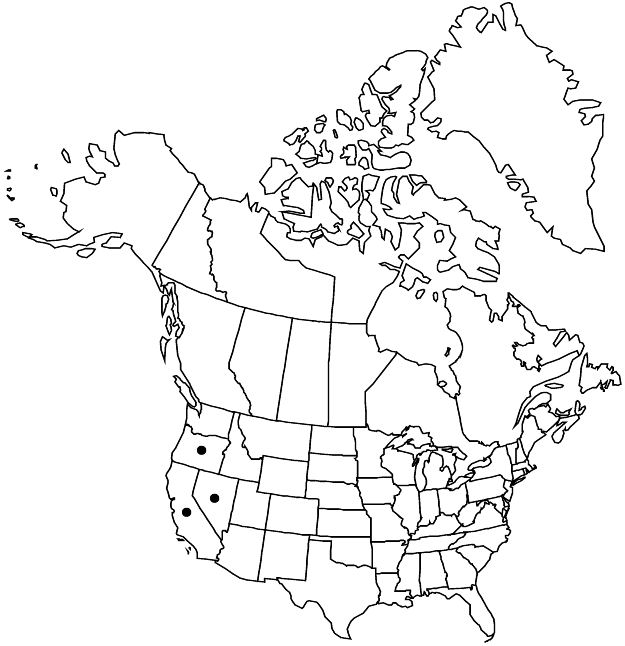Difference between revisions of "Drymocallis glandulosa var. reflexa"
J. Bot. Res. Inst. Texas 1: 43. 2007.
FNA>Volume Importer |
imported>Volume Importer |
||
| (6 intermediate revisions by 2 users not shown) | |||
| Line 8: | Line 8: | ||
}} | }} | ||
|common_names=Greene’s drymocallis or wood beauty | |common_names=Greene’s drymocallis or wood beauty | ||
| − | |basionyms={{Treatment/ID/ | + | |basionyms={{Treatment/ID/Basionym |
|name=Potentilla glandulosa var. reflexa | |name=Potentilla glandulosa var. reflexa | ||
|authority=Greene | |authority=Greene | ||
| + | |rank=variety | ||
| + | |publication_title=Fl. Francisc., | ||
| + | |publication_place=65. 1891 | ||
}} | }} | ||
|synonyms={{Treatment/ID/Synonym | |synonyms={{Treatment/ID/Synonym | ||
|name=Drymocallis glandulosa subsp. reflexa | |name=Drymocallis glandulosa subsp. reflexa | ||
|authority=(Greene) Soják | |authority=(Greene) Soják | ||
| − | }}{{Treatment/ID/Synonym | + | |rank=subspecies |
| + | }} {{Treatment/ID/Synonym | ||
|name=P. glandulosa subsp. reflexa | |name=P. glandulosa subsp. reflexa | ||
|authority=(Greene) D. D. Keck | |authority=(Greene) D. D. Keck | ||
| + | |rank=subspecies | ||
}} | }} | ||
|hierarchy=Rosaceae;Rosaceae subfam. Rosoideae;Rosaceae tribe Potentilleae;Drymocallis;Drymocallis glandulosa;Drymocallis glandulosa var. reflexa | |hierarchy=Rosaceae;Rosaceae subfam. Rosoideae;Rosaceae tribe Potentilleae;Drymocallis;Drymocallis glandulosa;Drymocallis glandulosa var. reflexa | ||
| Line 33: | Line 38: | ||
|elevation=400–2600 m | |elevation=400–2600 m | ||
|distribution=Calif.;Nev.;Oreg.;Mexico (Baja California). | |distribution=Calif.;Nev.;Oreg.;Mexico (Baja California). | ||
| − | |discussion=<p>At its morphologic extreme, var. reflexa is distinctive in its small, elliptic-oblanceolate, reflexed yellow petals, and widely branched inflorescences; however, in northern California and southern Oregon, var. reflexa and var. glandulosa completely intergrade. As circumscribed here, var. reflexa occurs at low to middle elevations in the mountains from northern Baja California, Mexico, and the Peninsular and Transverse ranges of southern California, through the Sierra Nevada to the mountains of northern California, barely entering adjacent Nevada and Oregon. Some disjunct collections from central Idaho approach this variety; their optimal disposition remains unclear.</p> | + | |discussion=<p>At its morphologic extreme, <i></i>var.<i> reflexa</i> is distinctive in its small, elliptic-oblanceolate, reflexed yellow petals, and widely branched inflorescences; however, in northern California and southern Oregon, <i></i>var.<i> reflexa</i> and <i></i>var.<i> glandulosa</i> completely intergrade. As circumscribed here, <i></i>var.<i> reflexa</i> occurs at low to middle elevations in the mountains from northern Baja California, Mexico, and the Peninsular and Transverse ranges of southern California, through the Sierra <i>Nevada</i> to the mountains of northern California, barely entering adjacent <i>Nevada</i> and Oregon. Some disjunct collections from central Idaho approach this variety; their optimal disposition remains unclear.</p> |
|tables= | |tables= | ||
|references= | |references= | ||
| Line 42: | Line 47: | ||
-->{{#Taxon: | -->{{#Taxon: | ||
name=Drymocallis glandulosa var. reflexa | name=Drymocallis glandulosa var. reflexa | ||
| − | |||
|authority=(Greene) Ertter | |authority=(Greene) Ertter | ||
|rank=variety | |rank=variety | ||
| Line 57: | Line 61: | ||
|publication year=2007 | |publication year=2007 | ||
|special status= | |special status= | ||
| − | |source xml=https:// | + | |source xml=https://bitbucket.org/aafc-mbb/fna-data-curation/src/2e0870ddd59836b60bcf96646a41e87ea5a5943a/coarse_grained_fna_xml/V9/V9_474.xml |
|subfamily=Rosaceae subfam. Rosoideae | |subfamily=Rosaceae subfam. Rosoideae | ||
|tribe=Rosaceae tribe Potentilleae | |tribe=Rosaceae tribe Potentilleae | ||
Latest revision as of 22:57, 5 November 2020
Stems 1.5–7.5 dm, base 1.5–3 mm diam. Leaves: basal (3–)6–20(–30) cm, leaflet pairs 3(–4); terminal leaflet ± broadly obovate, (1–)1.5–5(–7) × 1–3 cm, teeth usually double, rarely single, 6–16 per side, apex rounded to obtuse; cauline well developed or reduced, leaflet pairs 2–3. Inflorescences (2–)10–30-flowered, ± leafy or not, usually wide, branch angles (15–)25–55°. Pedicels 2–10 (proximal to 20) mm. Flowers: epicalyx bractlets narrowly elliptic, 1.5–4 × 0.5–1(–1.5) mm; sepals reflexed, (3–)4–6(–8) mm, apex usually obtuse, sometimes acute; petals reflexed, yellow, narrowly ovate or obovate, 3–4(–5) × 1.5–3 mm; filaments 0.5–1.5(–2) mm. Achenes 0.9–1.3 mm. 2n = 14.
Phenology: Flowering May–Aug.
Habitat: Moist, somewhat shaded places, often somewhat disturbed
Elevation: 400–2600 m
Distribution

Calif., Nev., Oreg., Mexico (Baja California).
Discussion
At its morphologic extreme, var. reflexa is distinctive in its small, elliptic-oblanceolate, reflexed yellow petals, and widely branched inflorescences; however, in northern California and southern Oregon, var. reflexa and var. glandulosa completely intergrade. As circumscribed here, var. reflexa occurs at low to middle elevations in the mountains from northern Baja California, Mexico, and the Peninsular and Transverse ranges of southern California, through the Sierra Nevada to the mountains of northern California, barely entering adjacent Nevada and Oregon. Some disjunct collections from central Idaho approach this variety; their optimal disposition remains unclear.
Selected References
None.